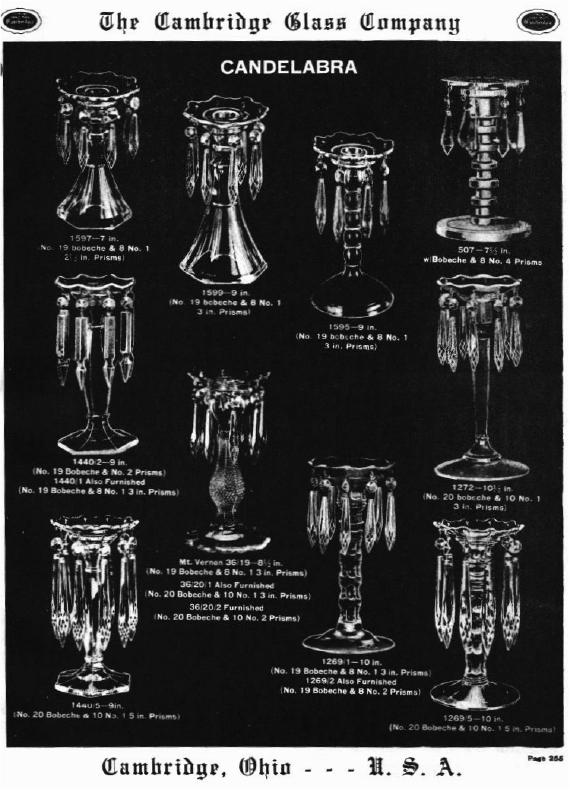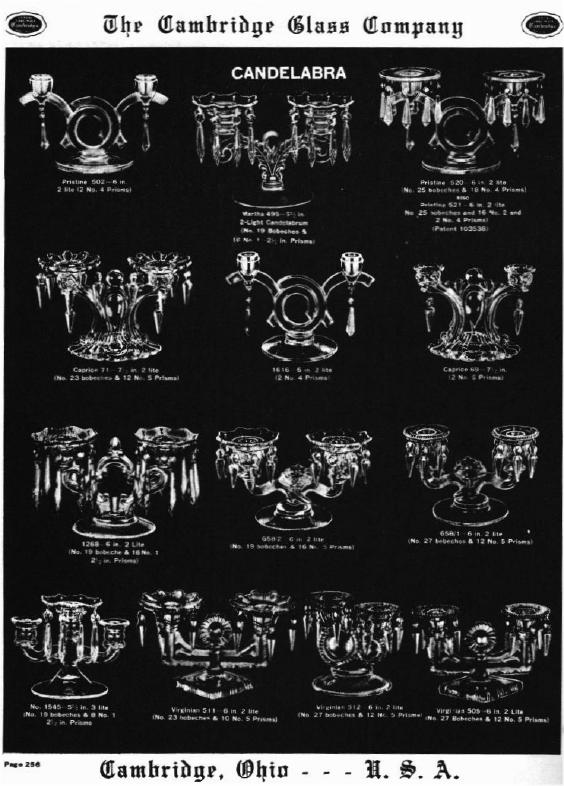Candlesticks, Part V
by Mark A. Nye
Issue No. 220 - August 1991
For this article we depart from the simple candlestick and instead turn to two of the pages from the 1940 Cambridge catalog (at end of the article) that illustrated candelabra, pages that were part of the original catalog issued January 1, 1940. All of the candelabra on these pages make use of, as their base, items that had been or were, at the time, also being sold as plain candlesticks.
Numbers 1597 and 1599 use as their base the #200/30 8" and #200/32 6" candlesticks, first seen in Cambridge catalog #10, issued circa 1920. There is a very similar candlestick, the #200/12, that can be distinguished by the shape of its base (round) and the candle-pocket. (It can be seen in the January 1991 issue of the CRYSTAL BALL.) The significant difference between the two candelabra, #1597 and #1599, as well as the original candlesticks, is their height. Also note that while both candelabra take the same style prism, the taller of the two, #1599, takes a 3" prism versus the 2½" used on the shorter. Although the two candelabra do not appear in the 1949 Cambridge catalog, another using the #200/32 candlestick does; it being the #652 10" 3-light candelabrum.
The #1595 candelabrum is based on a candlestick that does not appear in any of the known Cambridge catalogs, but probably originated during the mid-1920s. The candlestick itself is known in several of the early transparent colors but by 1940, with the addition of the bobeche collar, was being made solely in crystal. Like many of the other 1940s candelabra, the #1595 was out of the Cambridge line before 1949.
The Pristine #498 7" candlestick with the addition of the #25 bobeche, with its smooth round edge and eight #4 prisms, becomes the #507 candelabrum seen here. Both the candlestick and the candelabrum were discontinued prior to 1949.
Using the familiar #19 bobeche, but with the less often seen #2 prisms, the #1440/2 candelabrum uses as its base, a candlestick identical in shape to the 7½" #200/6 shown in the 1920 catalog. Later, it became known simply as #1440 and, as the #1440, this candelabrum was offered in the 1949 Cambridge catalog.
Made up of the #636 candlestick, which was in production by 1927, a #20 bobeche and ten #1 3" prisms, the #1272 candelabrum was earlier seen in a supplement to the 1930 Cambridge catalog. The page on which it was shown in that supplement carried the title "Lustre Cut Prism Candlesticks" with a note "Patented Lock Bobeche," and on a page in the 1932 catalog supplement is found an illustration showing the candelabrum engraved #629. This item was not part of the Cambridge line when the 1949 catalog was issued.
The Mt. Vernon candelabrum was first seen as Mt. Vernon #36, on page 29 in the 1932 Cambridge catalog supplement. Shown with the #2 prisms, its base was, and is, the Mt. Vernon #35 8" candlestick. By 1940, and probably before, it was being offered in three versions, as indicated in the caption to the 1940 catalog illustration, the differences being in the bobeche and prisms; #36/19 utilized a #19 bobeche and #1 3" prisms, while #36/20/1 used the original #2 prism and the #20 bobeche. None of the Mt. Vernon candelabra made it into the 1949 Cambridge catalog.
Using the same candlestick base as the #1440/2, the #1440/5 candelabrum has 5" #1 prisms suspended from a #20 bobeche which uses ten prisms, opposed to the eight prisms found on the #19 bobeche.
The old Centennial line #3 candlestick from the mid-to-late 1920s, and known in 1940 as the Martha Washington #3, is shown here being used as the base of three different candelabrum that vary in their use of either the #19 or #20 bobeche and the prism style and length. The #1269/1 uses the #19 bobeche and 3" #1 prisms; and the #1269/2 also uses the #19 bobeche, but with style #2 prisms; while #1269/5 comprised of the basic candlestick, a #20 bobeche and 5" #1 prisms. Like the Mt. Vernon items, these too were out of the Cambridge catalog prior to 1949.
As of January 1, 1940, none of the preceding candelabra were available in color. At the time, the most expensive were the #1440/5 and #1269/5, listed at $105 per dozen; while the least expensive, the #1597, was listed at $45 per dozen.
The Pristine and Virginian candelabra found on the second catalog page, reprinted here, were mentioned in Part IV, published in the July 1991 CB. Read carefully the captions underneath the illustrations. For instance, the Pristine #521 candelabrum makes use of two #25 bobeche, 16 #2 prisms (eight on each bobeche) and suspended from each candle pocket, a #4 prism. Compare this to the Pristine #520 which uses only #4 prisms.
At first glance the #1616 appears to be identical to the Pristine #502, but it is not. The base is different; the Pristine item having the characteristic molded Pristine base while the #1616 does not, probably have a cast foot.
Referred to as both a candlestick and a candelabrum, the Caprice #69 was offered in moonlight and crystal as 1940 began, plain and alpine, as was the Caprice #71 candelabrum. Using the #23 bobeche and #5 prisms, it listed for $82.50 per dozen, while the Caprice #69 listed for only $26.25 per dozen. With the addition of ten prisms and two bobeche, the list price per item jumped from $2.18 to $6.90, quite an increase.
The #1268 makes use of a familiar base, the #647 candlestick, and like the Caprice items, was, at the beginning of 1940, available in moonlight as well as crystal.
Candelabra #658/1 and #658/2 both make use of the #657 Rams Head candleholder with a cornucopia of fruit in its center. While not visible in these illustrations, there is a ram's head underneath each end of the diamond shaped candle pocket. First seen in the mid-1930s, these Gadroon line pieces were discontinued during the 1940s. Probably made only in crystal, they will be found etched Rose Point, Wildflower and Elaine. Note the use of the infrequently seen #27 bobeche as a component of the #658/1.
The #1545 5½" 3-lite candelabrum makes use of the short version of the #1307 candlestick, and while by 1940 was being made only in crystal, was during the 1930s made in many, if not all, of the prevailing colors. The candlestick will be found with many of the etchings from the 1930s, including Rose Point, Elaine, Diane, Wildflower and Portia. The taller version of this candlestick was offered in the 1949 catalog while the shorter style continued to be available as a part of the #1545 candelabra and two epergnes, #645 and #663.
The Virginian candlesticks were discussed in Part IV of this series. Seen here are three of the candelabra mentioned in that article. Two of these, #509 and #512 make use of the less frequently seen #27 bobeche.
As the captions and illustrations on these two catalog pages indicate, bobeches varied as to the number of prisms each used, as well as in their shape. The #23 bobeche uses five prisms, while the #27 uses six, and when properly assembled, the #19 has eight prisms suspended from it. Using the most prisms is the #20 which requires ten.
This is by no means all the Cambridge candelabra. Many more will be found as a large number of the candlesticks made over the years at the Cambridge factory were given a bobeche collar and turned into candelabra.
A future article will take a look at epergnes and epergnettes, items made to hold flowers and candles.


